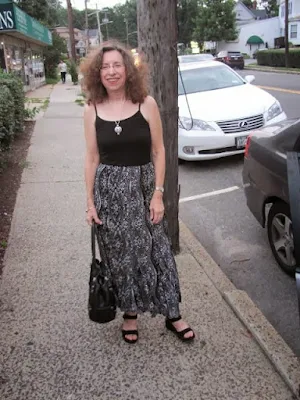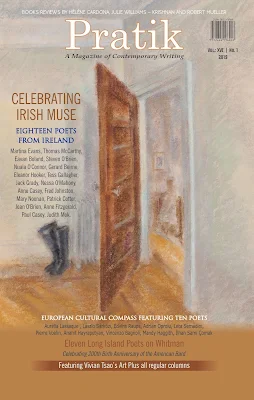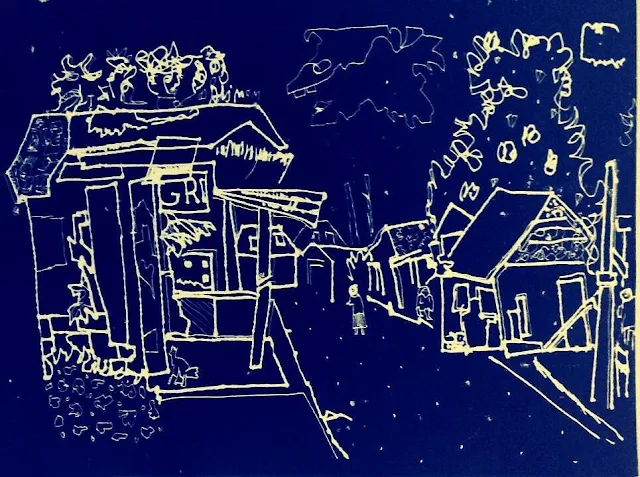Soul retrieval, deep healing
Anne Fitzgerald’s recent collection Vacant Possession
(Salmon Poetry) is exquisitely crafted, a beautiful, heartbreaking and haunting
read, which begs revisiting time and again. It opens with a stunning, hypnotic
love poem which casts a spell and sets the tone, for this is, above else, a
book about love: From afar it comes like the smell of rain;
Anticipation
From afar it comes like the smell of rain
in off the sea, with an urgency of waves
breaking, you weaken at the thought
of it happening again, as naturally as heat
making its presence felt on the globe
of your palms, you spread your fingers
wide as water between two bodies
of land, trace boundaries, sea stacks ‘n’ coves
on the bend of where paradise might
be your judgement clouds like a compass
that’s let moisture in, devoid of magnetic
field you falter, give way to the rhythm
of waves as though sirens in pursuit of kelp
and driftwood like lovers on a beach.
In poems about redemption and a love that transcends all,
Fitzgerald works to reconcile the world she knew with the world she lives in.
She writes about finding her compass, her mother, her identity. From “Finding
Myself in Werburgh Street”:
Theseus thread of Adriane, nurse Gallagher
cuts the chord, registers me by her own hand,
every slope and ink incline a natural fabrication
of this twenty-six year old’s maiden name, who
didn’t comfort me as my first tooth breaks through,
hold me at night as my breath is given over to
coughing for the loss of you, or watch me not fall
down as one foot follows the other in a gait you’d
half recognise disappearing into a crowd years later.
Instead you commend me into the geometry of a life
you’d not foresee, all the while, wondering from a
distance.
And from “Bellybutton”:
my first breath-cry
clouds windows,
lines my lungs
with a dampness
my breathing
will carry like
the pain of arrival
and your departure
into thin air
born like the memory
of mist falling
on bracken,
suspending disbelief,
myinnie pit
our belly to belly
chord leaves,
is all that
remains
of our attachment.
When witnessing her mother’s death, she mourns, “When
whiteness does hold / the world as I know it is no more.” … “a blizzard / of
disbelief / whitens my / world as / I knew it.”
The triumph of Vacant Possession is that Fitzgerald,
against all odds, deftly and with unparalleled grace, rediscovers and
repossesses the lost parts of herself.For this is poetry as shamanic work, soul
retrieval, deep healing and testimony, as well as a searing indictment of a
society where mothers and their children born out of wedlock have been prey at
the hands of the Catholic Church.
For this is poetry as shamanic work, soul retrieval, deep
healing and testimony, as well as a searing indictment of a society where
mothers and their children born out of wedlock have been prey at the hands of
the Catholic Church.
Fitzgerald conducted astounding research. To quote her
postscript, “From engagement with various State and Church agencies together
with research conducted I can confirm that Éire’s Architecture of Containment
thrives in matters pertaining to the release of Adoption Records in
Twenty-First Century Ireland. A trinity of control and culpability pervades
within the Catholic Church, the Irish Free State and its Religious Institutions
specifically established to contain, to profit from and to manage the lives of
those who bore children outside marriage and the little lives born outside of the
bands of holy matrimony.”
At once lyrical and precise, Vacant Possession stands as
witness, a heartfelt tribute to her mother and to all who underwent such fates.
This is a powerful and necessary collection on the human condition that
everyone needs to read.
Vacant Possession
by Anne Fitzgerald
Salmon Poetry, 2017
ISBN-13: 978-1910669976
€12; 146 pages
Hélène Cardona’s seven award-winning books include Life
in Suspension and Dreaming My Animal Selves, and the translations Birnam Wood (José Manuel Cardona), Beyond Elsewhere (Gabriel
Arnou-Laujeac), Ce que nous portons (Dorianne Laux), and Walt Whitman’s
Civil War Writings for WhitmanWeb. Her work has been translated into 16 languages. The
recipient of numerous honors, she holds an MA (American Literature, Sorbonne),
received fellowships (Goethe-Institut, Andalucía International University) and
taught at Hamilton College and Loyola Marymount University.
Amazon Link

































